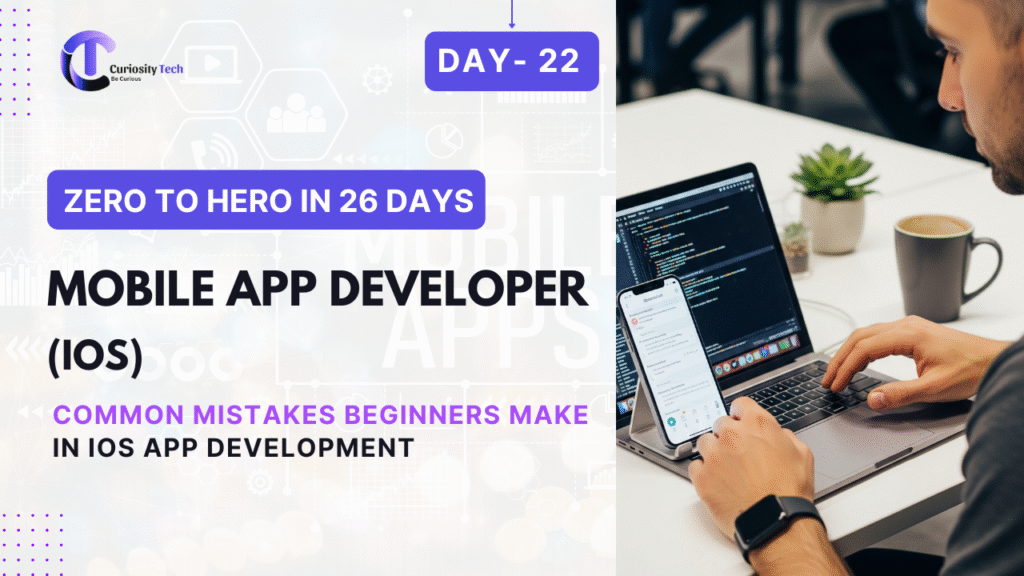Becoming an iOS developer is exciting, but for beginners, the learning curve can be overwhelming. Swift and SwiftUI make development approachable, but creating production-ready iOS apps requires mastering design principles, platform constraints, security, performance, and Apple’s review guidelines. Many developers rush into coding without foundational understanding — this leads to apps that crash, drain battery, get rejected, or fail in the real world.
In this guide, I’ll cover all mandatory mistakes beginners make, explain why they matter, and show you how to fix them with practical strategies. We’ll mix in real-world experience from CuriosityTech.in projects, where we’ve seen countless rookie errors and trained developers to overcome them.
1) Not Understanding the iOS Ecosystem
- Mistake: Jumping into code without learning Apple’s ecosystem: Xcode, Interface Builder, Swift, SwiftUI, UIKit, frameworks (Core Data, AVKit, MapKit).
- Impact: Developers get lost in toolchains, misuse frameworks, and reinvent solutions Apple already provides.
- Fix:
- Learn Xcode deeply (navigators, simulators, Instruments, debugging).
- Explore Apple frameworks before using third-party libraries.
- Read Apple’s Human Interface Guidelines (HIG) and iOS Developer Documentation.
- Learn Xcode deeply (navigators, simulators, Instruments, debugging).
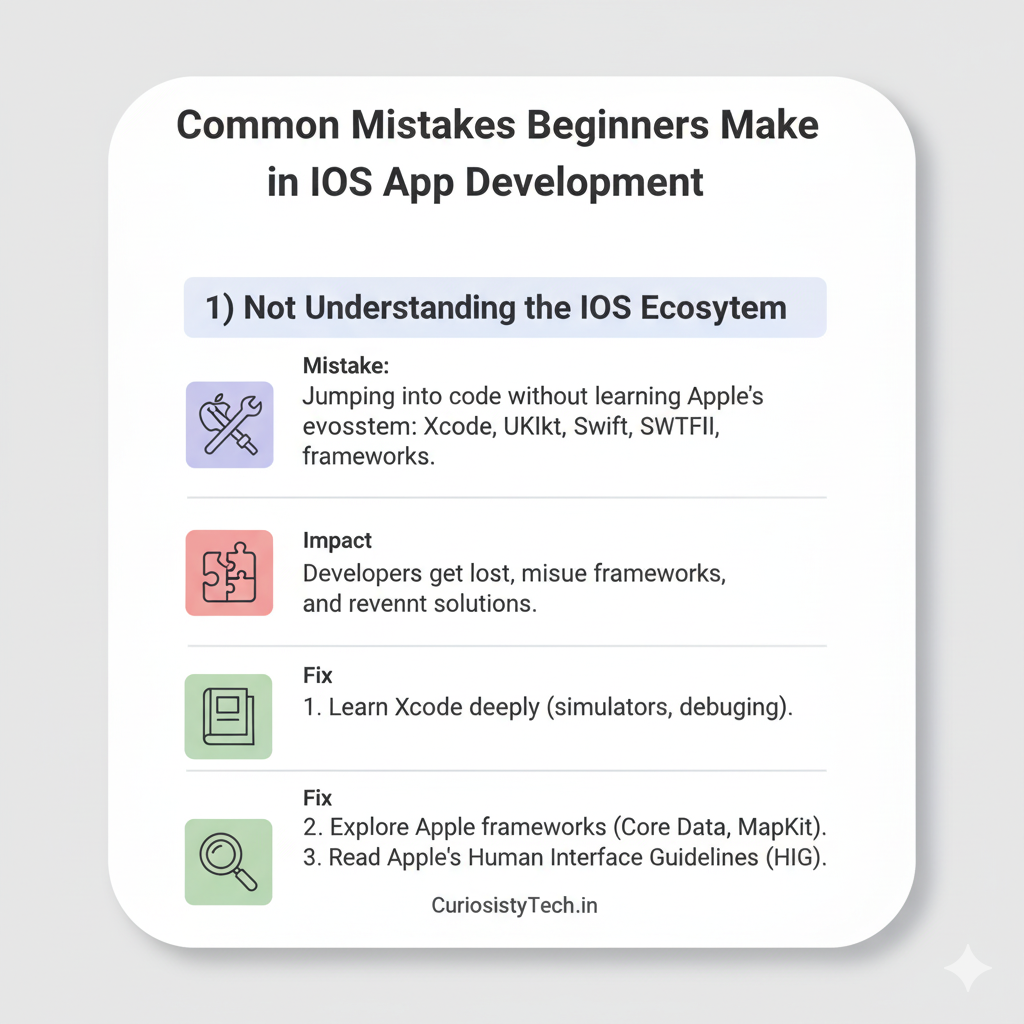
2) Poor Project Structure
- Mistake: Beginners dump all files into one folder, mix UI code with business logic, and create “God ViewControllers” with thousands of lines.
- Impact: Hard to maintain, debug, or extend the app. Collaboration becomes impossible.
- Fix:
- Follow MVC, MVVM, or VIPER patterns.
- Keep models, views, controllers, and services in separate groups.
- Use protocols and dependency injection for testability.
- Follow MVC, MVVM, or VIPER patterns.
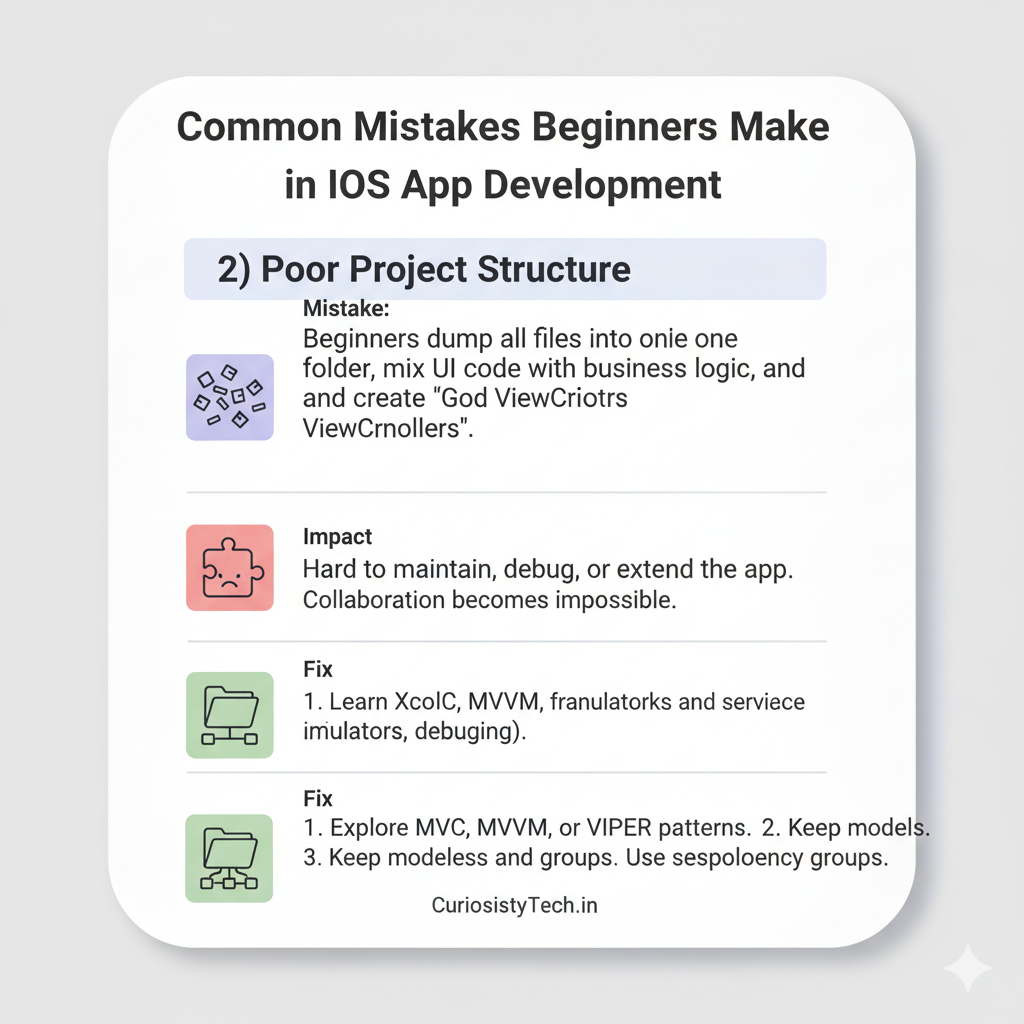
3) Misusing Storyboards & Auto Layout
- Mistake: Overusing Storyboards with massive UI flows, or not understanding Auto Layout constraints. Beginners often rely on “magic numbers” or hardcoded frames.
- Impact: UI breaks on different devices (iPhone SE vs. iPhone Pro Max vs. iPad).
- Fix:
- Use Auto Layout constraints or SwiftUI responsive design.
- Test across multiple device sizes with Preview in SwiftUI or Simulator in UIKit.
- Avoid giant storyboards — modularize UI flows into smaller storyboards or SwiftUI views.
- Use Auto Layout constraints or SwiftUI responsive design.
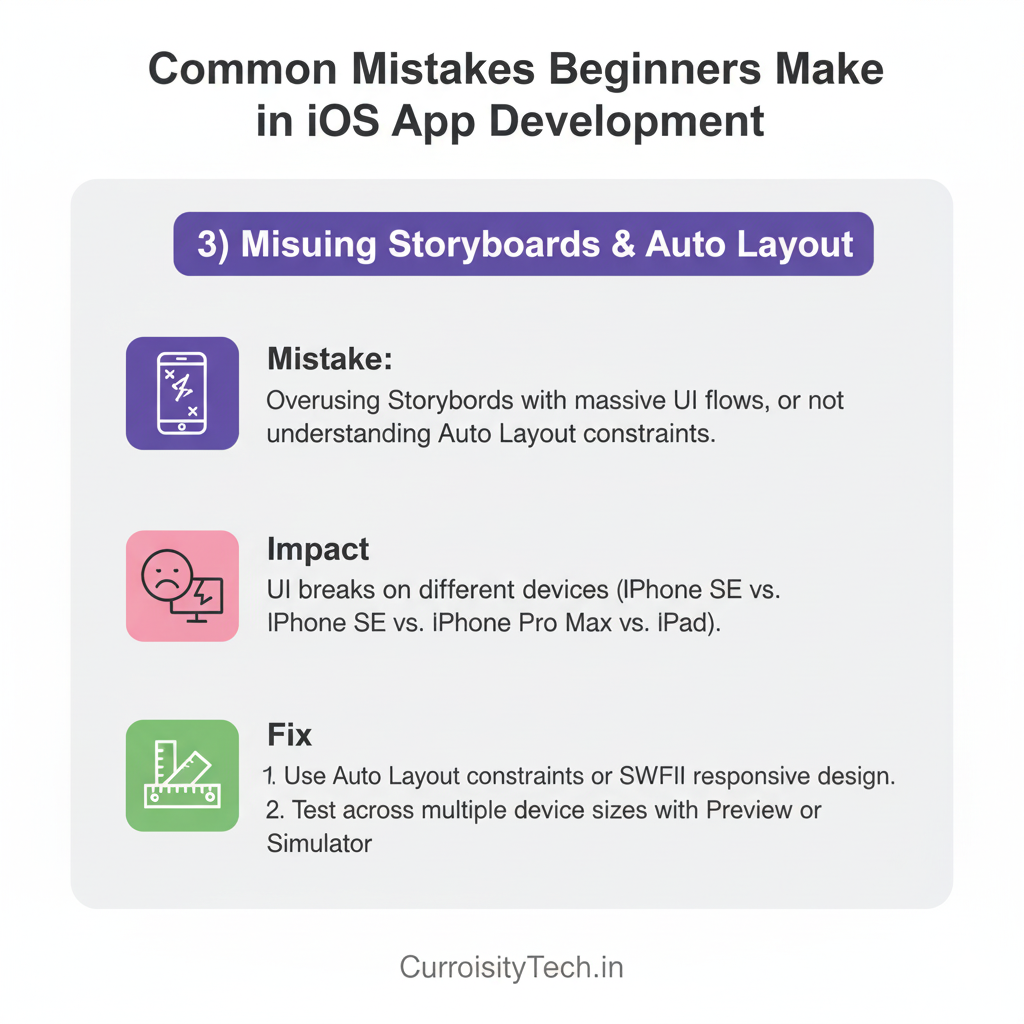
4) Ignoring Swift Basics & Best Practices
- Mistake: Beginners misuse optionals, force unwrap values (!), and ignore Swift’s safety features.
- Impact: Crashes like “Unexpectedly found nil while unwrapping an Optional.”
- Fix:
- Use if let, guard let, and optional chaining.
- Learn value types (structs) vs reference types (classes).
- Use Codable, Result, async/await instead of writing error-prone boilerplate.
- Use if let, guard let, and optional chaining.
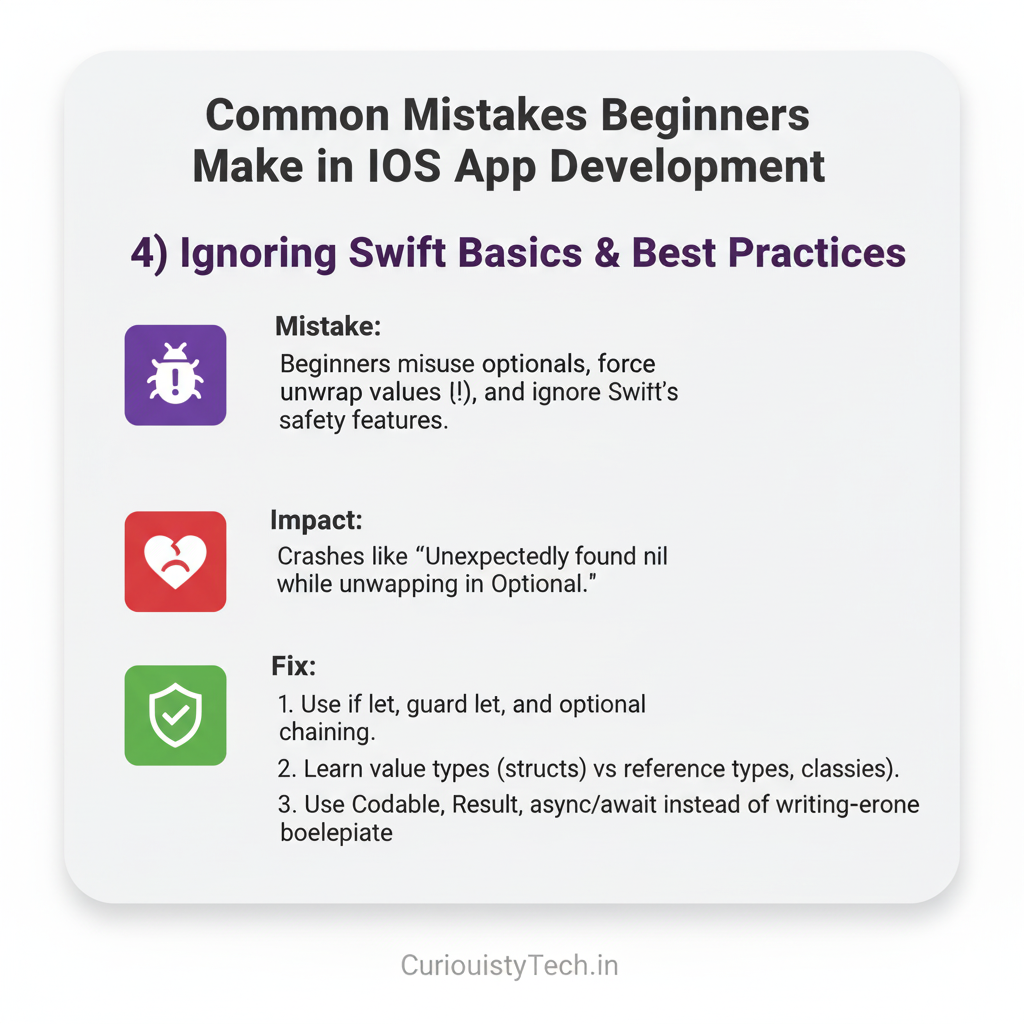
5) Weak Data Persistence Strategies
- Mistake: Storing data in UserDefaults instead of Core Data or secure storage.
- Impact: Sensitive data leaks, poor performance for large datasets.
- Fix:
- Use UserDefaults only for small preferences.
- Use Core Data or Realm for structured data.
- Store tokens/credentials in Keychain.
- Use UserDefaults only for small preferences.
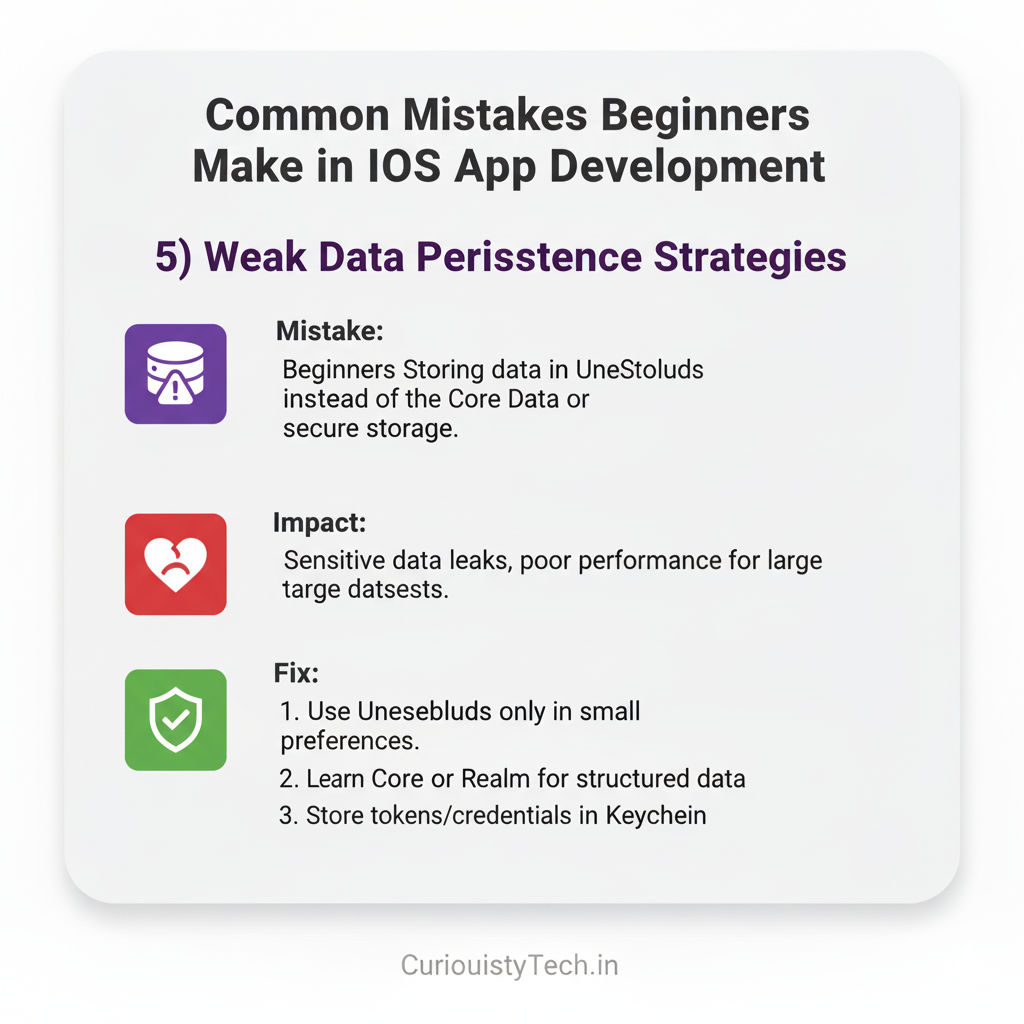
6) Poor Networking Practices
- Mistake: Beginners often:
- Disable ATS (App Transport Security).
- Hardcode API keys in the code.
- Block UI with synchronous network calls.
- Disable ATS (App Transport Security).
- Impact: Insecure apps, bad UX, rejection from App Store.
- Fix:
- Use URLSession with async/await.
- Store API keys securely (Keychain + backend validation).
- Implement retries, exponential backoff, and graceful error handling.
- Use URLSession with async/await.
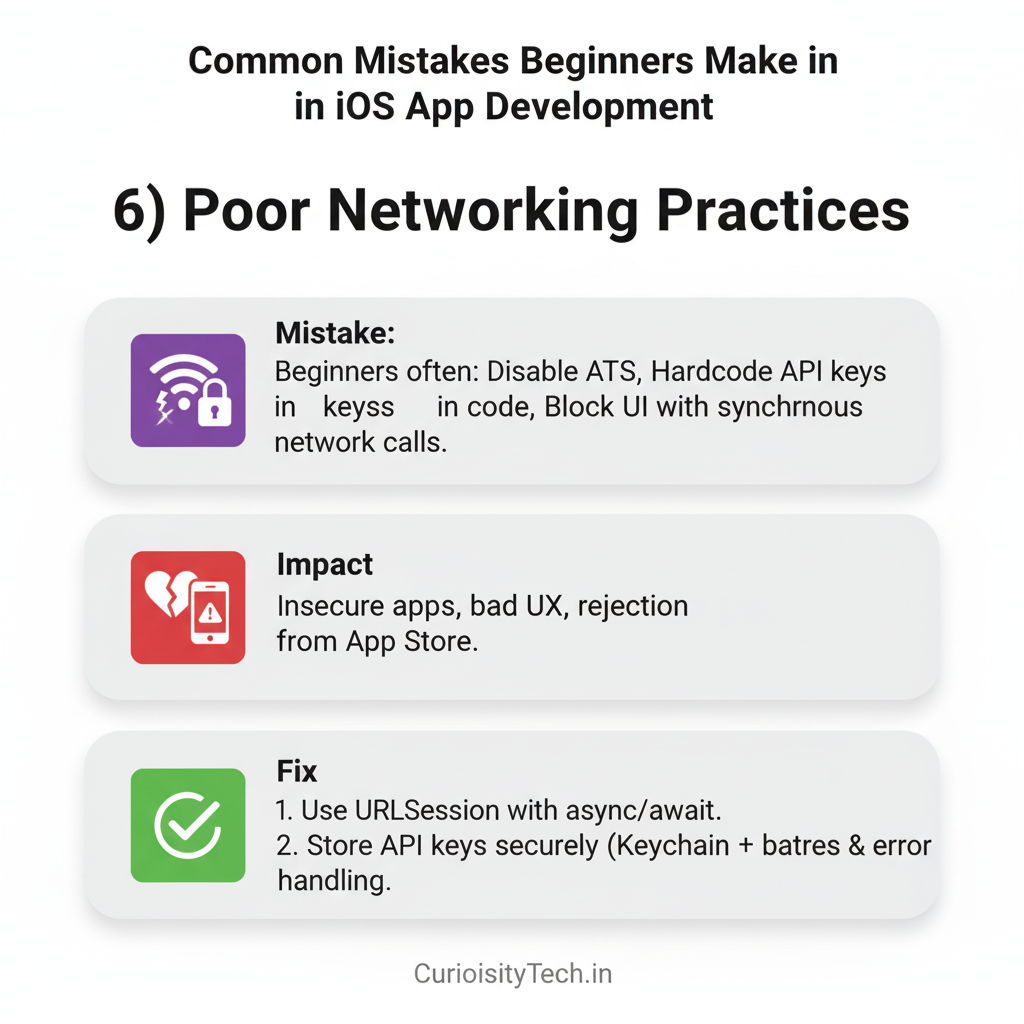
7) No Error Handling or Testing
- Mistake: Ignoring edge cases (no internet, API failures, invalid user input).
- Impact: Crashes, unhappy users, poor ratings.
- Fix:
- Handle errors explicitly with Swift Result or throws.
- Write unit tests with XCTest and UI tests.
- Use dependency injection for testable services.
- Handle errors explicitly with Swift Result or throws.
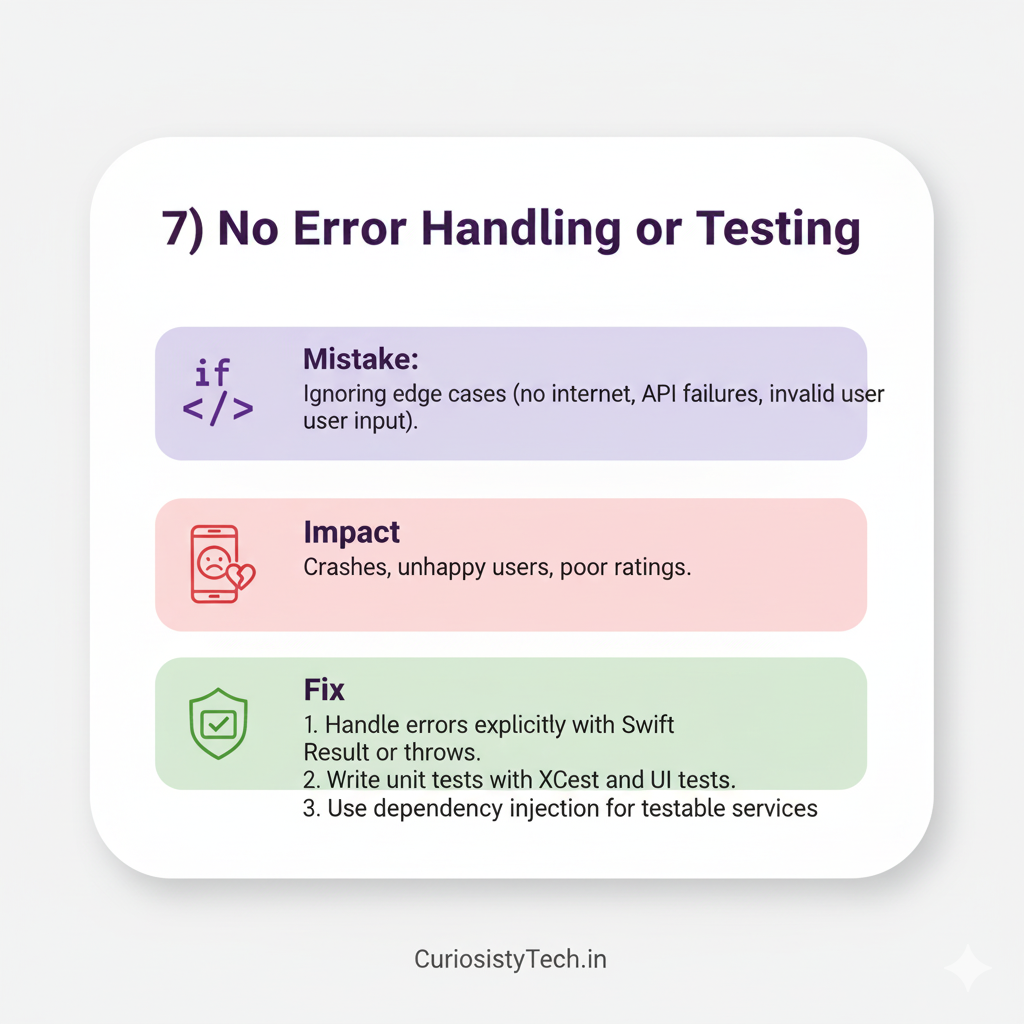
8) Performance Issues
- Mistake: Beginners often:
- Load images synchronously on main thread.
- Keep large arrays in memory.
- Ignore battery and CPU profiling.
- Load images synchronously on main thread.
- Impact: Slow apps, battery drain, memory crashes.
- Fix:
- Use DispatchQueue or async/await for background work.
- Use Instruments for memory leaks and CPU profiling.
- Cache images/data (e.g., with NSCache).
- Use DispatchQueue or async/await for background work.
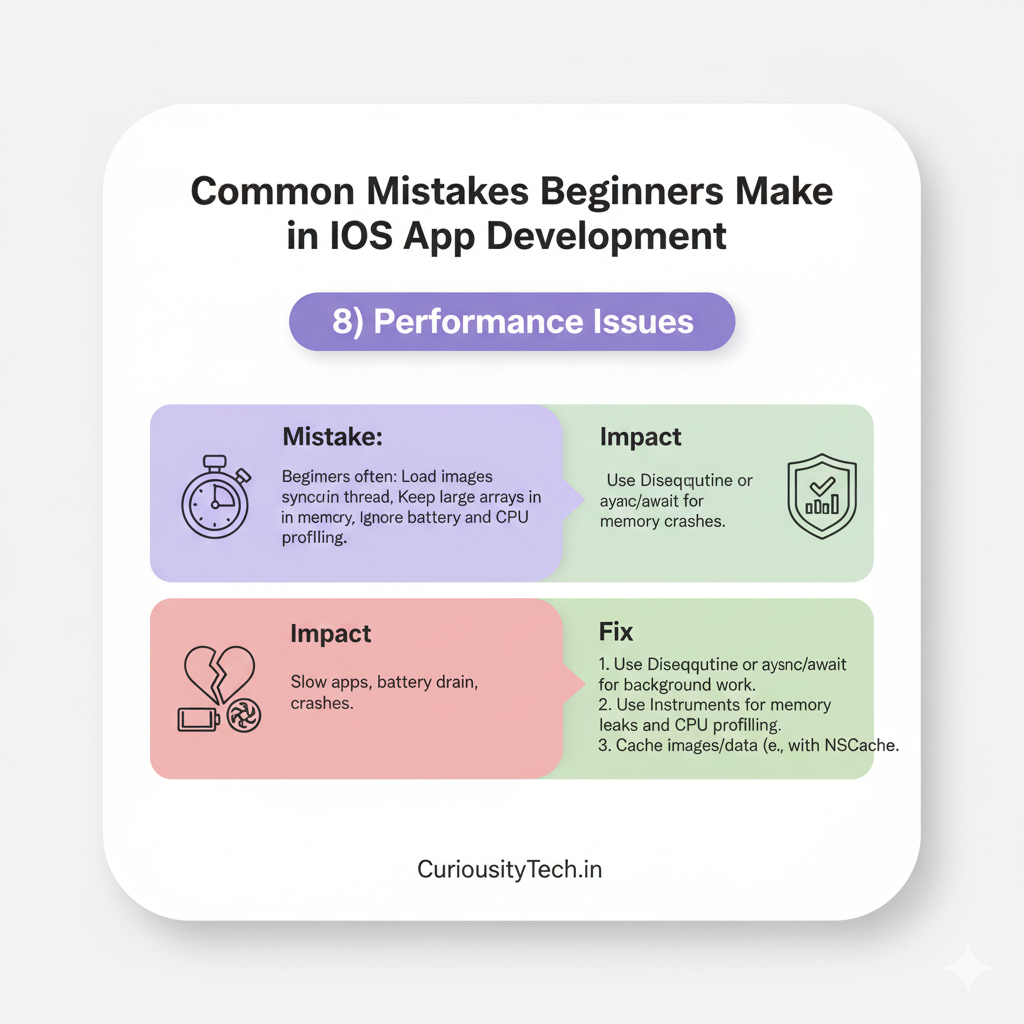
9) Overusing Third-party Libraries
- Mistake: Beginners install libraries for everything (networking, JSON parsing, UI widgets) instead of learning Apple frameworks.
- Impact: Bloated app, security risks, dependency hell.
- Fix:
- Use URLSession for networking before Alamofire.
- Use Codable before third-party JSON parsers.
- Add external libraries only when truly necessary.
- Use URLSession for networking before Alamofire.
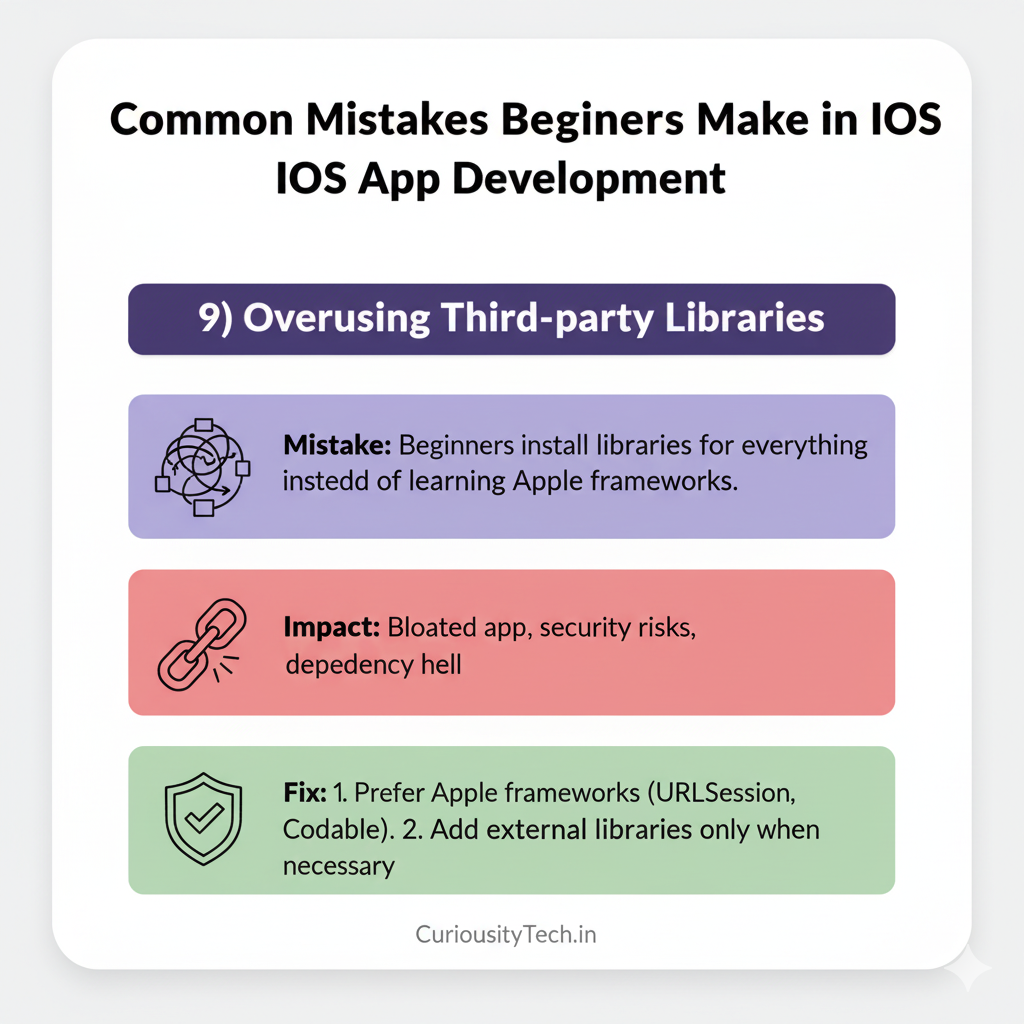
10) Not Following Apple’s Human Interface Guidelines (HIG)
- Mistake: Designing Android-style UI or ignoring iOS conventions (back buttons, tab bars, gestures).
- Impact: Poor user experience, App Store rejection.
- Fix:
- Study Apple HIG carefully.
- Use system components (SF Symbols, Dynamic Type, Haptics).
- Provide light/dark mode support.
- Study Apple HIG carefully.
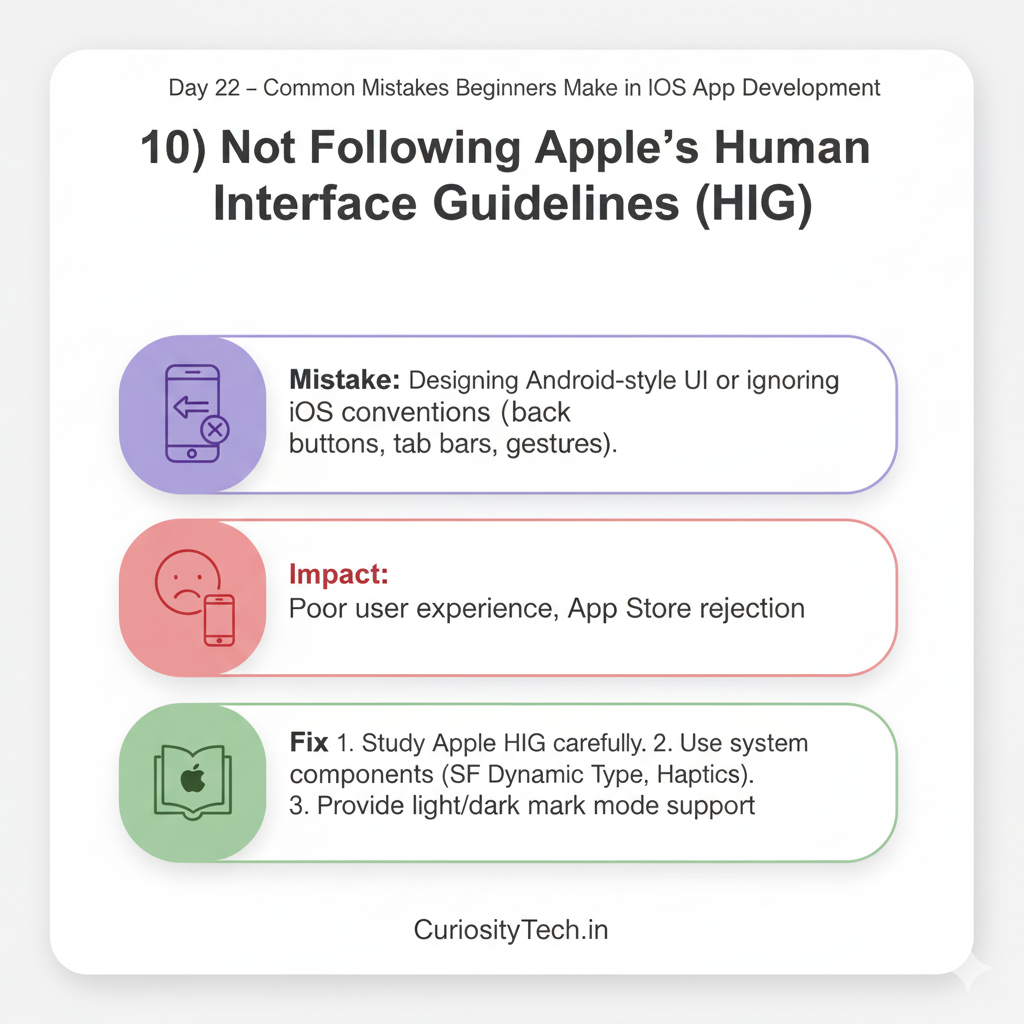
11) Weak Security Practices
- Mistake: Beginners often:
- Store passwords in plain text.
- Ignore biometrics.
- Skip certificate pinning.
- Store passwords in plain text.
- Impact: User data leaks, non-compliance with regulations.
- Fix:
- Use Keychain for credentials.
- Add Face ID/Touch ID with LocalAuthentication.
- Use HTTPS + certificate pinning.
- Use Keychain for credentials.
12) Not Preparing for App Store Review
- Mistake: Submitting without reading App Store guidelines, missing metadata, or not providing test accounts.
- Impact: Rejections and delays.
- Fix:
- Review Apple’s App Store Review Guidelines.
- Provide clear privacy policy & data usage disclosures.
- Submit valid test accounts for login-required apps.
- Review Apple’s App Store Review Guidelines.
13) Ignoring Accessibility
- Mistake: Skipping VoiceOver, Dynamic Type, and contrast checks.
- Impact: Exclusion of users with disabilities, bad ratings, rejection.
- Fix:
- Test with Accessibility Inspector.
- Use semantic UI elements (buttons, labels).
- Support Dynamic Type for text resizing.
- Test with Accessibility Inspector.
14) Lack of Version Control & Collaboration
- Mistake: Beginners don’t use Git or commit everything in one branch.
- Impact: Lost code, messy merges, no collaboration.
- Fix:
- Use Git + GitHub/GitLab/Bitbucket.
- Commit small, meaningful changes.
- Use branches (feature, bugfix, release).
- Use Git + GitHub/GitLab/Bitbucket.
15) Underestimating Documentation & Maintenance
- Mistake: No README, no inline comments, no API documentation.
- Impact: Future developers (and even you) can’t understand the project.
- Fix:
- Write README with setup instructions.
- Add inline comments where logic is complex.
- Use DocC for Swift API documentation.
- Write README with setup instructions.
Tabular Recap
| Category | Beginner Mistake | Fix |
| Ecosystem | Not learning frameworks | Study Xcode, Apple APIs |
| Project structure | God ViewControllers | Use MVC/MVVM/VIPER |
| UI | Hardcoded frames | Auto Layout / SwiftUI |
| Swift | Force unwrap optionals | Use guard let, if let |
| Data | Store in UserDefaults | Use Core Data/Keychain |
| Networking | Hardcoded keys, sync calls | Keychain, async/await |
| Testing | No tests | XCTest, UI testing |
| Performance | Blocking main thread | Background threads, Instruments |
| Libraries | Overuse third-party | Prefer Apple frameworks |
| UX | Ignore HIG | Follow Apple design |
| Security | Plain text storage | Keychain, HTTPS |
| App Store | Missing guidelines | Review rules, test accounts |
| Accessibility | Ignored | VoiceOver, Dynamic Type |
| Version control | No Git | GitHub/GitLab workflow |
| Maintenance | No docs | README + DocC |
Becoming an Expert
To move beyond beginner mistakes, developers should:
- Build multiple apps (practice beats theory).
- Review Apple’s WWDC videos every year.
- Profile with Instruments early.
- Contribute to open-source iOS projects.
- Learn security, accessibility, and performance optimization as mandatory, not optional.
At CuriosityTech.in, we teach these as part of our “Zero to Professional iOS Developer” program, ensuring students don’t just learn Swift, but also industry standards like Git workflow, security best practices, and Apple review preparation.
Conclusion
Most beginner mistakes come from rushing and ignoring fundamentals. Avoiding these mistakes will make your apps stable, secure, performant, and App Store ready. Learn the ecosystem, structure projects properly, embrace testing, and prioritize user experience. By doing so, you’ll grow from a beginner to a professional who builds apps that users trust and love.

